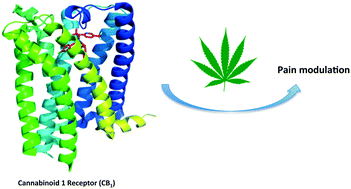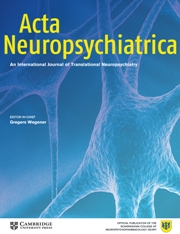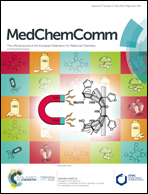 “The endocannabinoid system is an endogenous pathway comprised of the cannabinoid receptors 1 and 2 (CB1 and CB2), their endogenous ligands known as endocannabinoids, and the enzymes responsible for their synthesis and degradation. The endocannabinoidome extends this system to include other receptors such as TRPV1, PPARα, GPR55 and 5-HT1A. An extensive amount of research is now linking the endocannabinoidome to intestinal health through fascinating mechanisms that include endocannabinoid receptor expression in the gut and interplay with the intestinal microbiota. A dysregulated endocannabinoid system may lead to inflammatory bowel disease and colon cancer.”
“The endocannabinoid system is an endogenous pathway comprised of the cannabinoid receptors 1 and 2 (CB1 and CB2), their endogenous ligands known as endocannabinoids, and the enzymes responsible for their synthesis and degradation. The endocannabinoidome extends this system to include other receptors such as TRPV1, PPARα, GPR55 and 5-HT1A. An extensive amount of research is now linking the endocannabinoidome to intestinal health through fascinating mechanisms that include endocannabinoid receptor expression in the gut and interplay with the intestinal microbiota. A dysregulated endocannabinoid system may lead to inflammatory bowel disease and colon cancer.”
Category Archives: Endocannabinoid System
The Endocannabinoid System and its Modulation by Cannabidiol (CBD).
 “The endocannabinoid system (ECS) is an extensive endogenous signaling system with multiple elements, the number of which may be increasing as scientists continue to elucidate its role in human health and disease. The ECS is seemingly ubiquitous in animal species and is modulated by diet, sleep, exercise, stress, and a multitude of other factors, including exposure to phytocannabinoids, like Cannabidiol (CBD). Modulating the activity of this system may offer tremendous therapeutic promise for a diverse scope of diseases, ranging from mental health disorders, neurological and movement disorders, pain, autoimmune disease, spinal cord injury, cancer, cardiometabolic disease, stroke, TBI, osteoporosis, and others.”
“The endocannabinoid system (ECS) is an extensive endogenous signaling system with multiple elements, the number of which may be increasing as scientists continue to elucidate its role in human health and disease. The ECS is seemingly ubiquitous in animal species and is modulated by diet, sleep, exercise, stress, and a multitude of other factors, including exposure to phytocannabinoids, like Cannabidiol (CBD). Modulating the activity of this system may offer tremendous therapeutic promise for a diverse scope of diseases, ranging from mental health disorders, neurological and movement disorders, pain, autoimmune disease, spinal cord injury, cancer, cardiometabolic disease, stroke, TBI, osteoporosis, and others.”
Selective modulation of the cannabinoid type 1 (CB1) receptor as an emerging platform for the treatment of neuropathic pain.
“Neuropathic pain is caused by a lesion or dysfunction in the nervous system, and it may arise from illness, be drug-induced or caused by toxin exposure. Since the discovery of two G-protein-coupled cannabinoid receptors (CB1 and CB2) nearly three decades ago, there has been a rapid expansion in our understanding of cannabinoid pharmacology. This is currently one of the most active fields of neuropharmacology, and interest has emerged in developing cannabinoids and other small molecule modulators of CB1 and CB2 as therapeutics for neuropathic pain. This short review article provides an overview of the chemotypes currently under investigation for the development of novel neuropathic pain treatments targeting CB1 receptors.”

Randomized Placebo-Controlled Trial of Nabilone for Agitation in Alzheimer’s Disease.

“Nabilone may be an effective treatment for agitation.”
https://www.ncbi.nlm.nih.gov/pubmed/31182351
https://www.sciencedirect.com/science/article/pii/S1064748119303550?via%3Dihub
“Nabilone (marketed as Cesamet) is a synthetic form of delta-9-tetrahydrocannabinol (Δ⁹-THC), the primary psychoactive component of cannabis (marijuana). Although structurally distinct from THC, nabilone mimics THC’s structure and pharmacological activity through weak partial agonist activity at Cannabinoid-1 (CB1R) and Cannabinoid-2 (CB2R) receptors, however it is considered to be twice as active as Δ⁹-THC. Nabilone is approved by the FDA for the treatment of nausea and vomiting associated with cancer chemotherapy in patients who have failed to respond adequately to conventional antiemetic treatments.” https://www.drugbank.ca/drugs/DB00486
The oncogenic role of CB2 in the progression of non-small-cell lung cancer.

“Several studies have verified the important role of cannabinoid and cannabinoid receptor agonists in tumor progression. However, little is known about the precise role of CB2 expression level in the progression of non-small-cell lung cancer (NSCLC).
The expression of CB2 in NSCLC tissues and corresponding paracancerous tissues was examined using immunohistochemical staining assay.
CONCLUSION:
Our data suggested that targeting CB2 may inhibit the growth and survival of NSCLC cells, which the Akt/mTOR/P70S6K pathway may be involved in. These results confer the pro-oncogenic role of CB2 in the progression of NSCLC, thus improving our understanding of CB2 in tumor progression.”
https://www.ncbi.nlm.nih.gov/pubmed/31176172
https://www.sciencedirect.com/science/article/pii/S0753332219321341?via%3Dihub
“Cannabinoid receptors, CB1 and CB2, as novel targets for inhibition of non-small cell lung cancer growth and metastasis. These results suggest that CB1 and CB2 could be used as novel therapeutic targets against NSCLC.” https://www.ncbi.nlm.nih.gov/pubmed/21097714
The cannabinoid receptor 2 agonist, β-caryophyllene, improves working memory and reduces circulating levels of specific proinflammatory cytokines in aged male mice.
 “Age-related cognitive decline has been associated with proinflammatory cytokines, yet the precise relationship between cognitive decline and cytokine load remains to be elucidated. β-caryophyllene (BCP) is a cannabinoid receptor 2 (CB2) agonist with established anti-inflammatory effects that is known to improve memory and increase lifespan. It is of interest to explore the potential of BCP to reduce age-related cognitive decline and proinflammatory cytokine load. In this study, we assessed changes in circulating cytokines across the lifespan, memory performance in young and aged mice, and the effects of BCP on memory function and cytokine load. The plasma levels of 12 cytokines were assessed in male Swiss-Webster mice at 3, 12, and 18 months of age using multiplexed flow cytometry. Working memory was compared in 3 and 12 month-old mice using spontaneous alternations. A dose-response function (100-300 mg/kg, subchronic administration) for BCP-induced memory restoration was determined in 3 and 12 month-old mice. Finally, the effects on cytokine levels of the peak memory enhancing dose of BCP was assessed in 18 month-old mice. Circulating levels of several cytokines significantly increased with age. Multilinear regression analysis showed that IL-23 levels were most strongly associated with age. Aged mice showed deficits in working memory and higher levels of IL-23, both of which were reversed by BCP treatment. BCP appears to reverse age-associated impairments in memory and modulates cytokine production. IL-23 may play a significant role in the aging process, and future research should determine whether it has utility as a biomarker for novel anti-aging therapeutics.”
“Age-related cognitive decline has been associated with proinflammatory cytokines, yet the precise relationship between cognitive decline and cytokine load remains to be elucidated. β-caryophyllene (BCP) is a cannabinoid receptor 2 (CB2) agonist with established anti-inflammatory effects that is known to improve memory and increase lifespan. It is of interest to explore the potential of BCP to reduce age-related cognitive decline and proinflammatory cytokine load. In this study, we assessed changes in circulating cytokines across the lifespan, memory performance in young and aged mice, and the effects of BCP on memory function and cytokine load. The plasma levels of 12 cytokines were assessed in male Swiss-Webster mice at 3, 12, and 18 months of age using multiplexed flow cytometry. Working memory was compared in 3 and 12 month-old mice using spontaneous alternations. A dose-response function (100-300 mg/kg, subchronic administration) for BCP-induced memory restoration was determined in 3 and 12 month-old mice. Finally, the effects on cytokine levels of the peak memory enhancing dose of BCP was assessed in 18 month-old mice. Circulating levels of several cytokines significantly increased with age. Multilinear regression analysis showed that IL-23 levels were most strongly associated with age. Aged mice showed deficits in working memory and higher levels of IL-23, both of which were reversed by BCP treatment. BCP appears to reverse age-associated impairments in memory and modulates cytokine production. IL-23 may play a significant role in the aging process, and future research should determine whether it has utility as a biomarker for novel anti-aging therapeutics.”
https://www.ncbi.nlm.nih.gov/pubmed/31173795
https://www.sciencedirect.com/science/article/pii/S0166432819304516?via%3Dihub
“β-caryophyllene (BCP) is a common constitute of the essential oils of numerous spice, food plants and major component in Cannabis.” http://www.ncbi.nlm.nih.gov/pubmed/23138934
“Beta-caryophyllene is a dietary cannabinoid.” https://www.ncbi.nlm.nih.gov/pubmed/18574142
Novel CB1-ligands maintain homeostasis of the endocannabinoid-system in ω3- and ω6-long chain-PUFA deficiency.
 “Mammalian ω3- and ω6-PUFAs are synthesized from essential fatty acids (EFAs) or supplied by the diet. PUFAs are constitutive elements of membrane-architecture and precursors of lipid signaling molecules. EFAs and long chain PUFAs are precursors in the synthesis of endocannabinoid-ligands of the Gi/o-protein coupled cannabinoid receptors 1 and 2 in the endocannabinoid-system, which critically regulates energy homeostasis, as metabolic signaling system in hypothalamic neuronal circuits, and behavioral parameters. We utilized the auxotrophic fatty acid desaturase 2 deficient (fads2-/-) mouse, deficient in long chain PUFA-synthesis, to follow the age dependent dynamics of the PUFA pattern in the CNS-phospholipidome in unbiased dietary studies of three cohorts on sustained long chain PUFA-free, ω6-arachidonic and ω3-docosahexaenoic acid supplemented diets and their impact on the precursor pool of CB1 ligands. We discovered the transformation of eicosa-all cis-5,11,14-trienoic acid, uncommon in mammalian lipidomes, into two novel endocannabinoids, 20:35,11,14-ethanolamide and 2-20:35,11,14-glycerol, acting as ligands of CB1 in HEK293-cells. Labeling experiments excluded a Δ8-desaturase activity and proved the position-specificity of FADS2. The fads2 -/- mutant might serve as an unbiased model in vivo in the development of novel CB1-agonists and antagonists.”
“Mammalian ω3- and ω6-PUFAs are synthesized from essential fatty acids (EFAs) or supplied by the diet. PUFAs are constitutive elements of membrane-architecture and precursors of lipid signaling molecules. EFAs and long chain PUFAs are precursors in the synthesis of endocannabinoid-ligands of the Gi/o-protein coupled cannabinoid receptors 1 and 2 in the endocannabinoid-system, which critically regulates energy homeostasis, as metabolic signaling system in hypothalamic neuronal circuits, and behavioral parameters. We utilized the auxotrophic fatty acid desaturase 2 deficient (fads2-/-) mouse, deficient in long chain PUFA-synthesis, to follow the age dependent dynamics of the PUFA pattern in the CNS-phospholipidome in unbiased dietary studies of three cohorts on sustained long chain PUFA-free, ω6-arachidonic and ω3-docosahexaenoic acid supplemented diets and their impact on the precursor pool of CB1 ligands. We discovered the transformation of eicosa-all cis-5,11,14-trienoic acid, uncommon in mammalian lipidomes, into two novel endocannabinoids, 20:35,11,14-ethanolamide and 2-20:35,11,14-glycerol, acting as ligands of CB1 in HEK293-cells. Labeling experiments excluded a Δ8-desaturase activity and proved the position-specificity of FADS2. The fads2 -/- mutant might serve as an unbiased model in vivo in the development of novel CB1-agonists and antagonists.”
l-α-Lysophosphatidylinositol (LPI) aggravates myocardial ischemia/reperfusion injury via a GPR55/ROCK-dependent pathway.

“The phospholipid l-α-lysophosphatidylinositol (LPI), an endogenous ligand for GPR55, is elevated in patients with acute coronary syndrome, and a GPR55 antagonist cannabidiol (CBD) reduces experimental ischemia/reperfusion (I/R) injury.”
https://www.ncbi.nlm.nih.gov/pubmed/31149342
https://bpspubs.onlinelibrary.wiley.com/doi/full/10.1002/prp2.487
Bipolar disorder and the endocannabinoid system.
 “Bipolar disorder (BD) is a debilitating, lifelong neuropsychiatric illness characterised by unsteady mood states which vacillate from (hypo)mania to depression. Despite the availability of pharmaceutical agents which can be effective in ameliorating the acute affective symptoms and prevent episodic relapse, BD is inadequately treated in a subset of patients.
“Bipolar disorder (BD) is a debilitating, lifelong neuropsychiatric illness characterised by unsteady mood states which vacillate from (hypo)mania to depression. Despite the availability of pharmaceutical agents which can be effective in ameliorating the acute affective symptoms and prevent episodic relapse, BD is inadequately treated in a subset of patients.
The endocannabinoid system (ECS) is known to exert neuromodulatory effects on other neurotransmitter systems critical in governing emotions. Several studies ranging from clinical to molecular, as well as anecdotal evidence, have placed a spotlight on the potential role of the ECS in the pathophysiology of BD. In this perspective, we present advantages and disadvantages of cannabis use in the management of illness course of BD and provide mechanistic insights into how this system might contribute to the pathophysiology of BD.
RESULTS:
We highlight the putative role of selective cannabinoid receptor 2 (CB2) agonists in BD and briefly discuss findings which provide a rationale for targeting the ECS to assuage the symptoms of BD. Further, data encourage basic and clinical studies to determine how cannabis and cannabinoids (CBs) can affect mood and to investigate emerging CB-based options as probable treatment approaches.
CONCLUSION:
The probable role of the ECS has been almost neglected in BD; however, from data available which suggest a role of ECS in mood control, it is justified to support conducting comprehensive studies to determine whether ECS manipulation could positively affect BD. Based on the limited available data, we suggest that activation of CB2 may stabilise mood in this disorder.”
Should Oncologists Recommend Cannabis?

“Cannabis is a useful botanical with a wide range of therapeutic potential. Global prohibition over the past century has impeded the ability to study the plant as medicine. However, delta-9-tetrahydrocannabinol (THC) has been developed as a stand-alone pharmaceutical initially approved for the treatment of chemotherapy-related nausea and vomiting in 1986. The indication was expanded in 1992 to include treatment of anorexia in patients with the AIDS wasting syndrome. Hence, if the dominant cannabinoid is available as a schedule III prescription medication, it would seem logical that the parent botanical would likely have similar therapeutic benefits. The system of cannabinoid receptors and endogenous cannabinoids (endocannabinoids) has likely developed to help us modulate our response to noxious stimuli. Phytocannabinoids also complex with these receptors, and the analgesic effects of cannabis are perhaps the best supported by clinical evidence. Cannabis and its constituents have also been reported to be useful in assisting with sleep, mood, and anxiety. Despite significant in vitro and animal model evidence supporting the anti-cancer activity of individual cannabinoids-particularly THC and cannabidiol (CBD)-clinical evidence is absent. A single intervention that can assist with nausea, appetite, pain, mood, and sleep is certainly a valuable addition to the palliative care armamentarium. Although many healthcare providers advise against the inhalation of a botanical as a twenty-first century drug-delivery system, evidence for serious harmful effects of cannabis inhalation is scant and a variety of other methods of ingestion are currently available from dispensaries in locales where patients have access to medicinal cannabis. Oncologists and palliative care providers should recommend this botanical remedy to their patients to gain first-hand evidence of its therapeutic potential despite the paucity of results from randomized placebo-controlled clinical trials to appreciate that it is both safe and effective and really does not require a package insert.”
https://www.ncbi.nlm.nih.gov/pubmed/31161270
https://link.springer.com/article/10.1007%2Fs11864-019-0659-9

